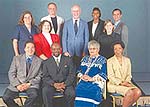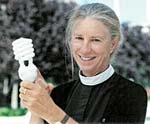By Jim Motavalli
When conservative evangelical Christians call for action on global warming, Hindu holy men dedicate themselves to saving sacred rivers and Buddhist monks work with Islamic mullahs to try to halt the extinction crisis, boundaries are clearly being redrawn in the ongoing struggle for the political hearts and minds of the world’s believers. Faith-based environmental activism is soaring.
One factor in the resurgence of faith-based environmentalism is the 1993 founding of the National Religious Partnership for the Environment (NRPE) by a former radio talk show host and spokesperson for New York City’s Episcopal Cathedral of St. John the Divine named Paul Gorman. NRPE quickly proved its effectiveness by joining together and helping educate such disparate and mainstream bodies as the U.S. Catholic Conference (the policy agency for all Catholic bishops, clergy and parishes), the National Council of Churches of Christ (a federation of Protestant, Eastern Orthodox and African-American denominations), the Coalition on the Environment and Jewish Life (COEJL, an alliance across all four Jewish movements) and the Evangelical Environmental Network (a coalition of evangelical Christian agencies and institutions).
With such dynamic leadership, churches are moving environmental concerns to the heart of their ministry, and they are calling on their congregants to take increasingly radical action. “A child born in a wealthy country is likely to consume, waste and pollute more in his lifetime than 50 children born in developing nations,” said the Archbishop of Canterbury in a New Year’s address on the eve of 2001. “It may not be time to build an ark like Noah, but it is high time to take better care of God’s creation.”
In 1997, the Patriarchate of the Greek Orthodox Church, Bartholomew I, used strong language against polluters. “To commit a crime against the natural world is a sin,” he said. “For humans to cause species to become extinct and to destroy the biological diversity of God’s creationfor humans to degrade the integrity of [the] Earth by causing changes in its climate, stripping the Earth of its natural forests or destroying its wetlandsfor humans to contaminate the Earth’s waters, its land, its air and its life with poisonous substances, these are sins,” he said.
In a 1990 World Day of Peace message, Pope John Paul II emphasized that Christian responsibility toward nature is an essential part of faith. Statements like these are common across many denominations, but it’s the concrete actions and growing faith-based activism that represents an important change.
Last June, Patriarch Bartholomew and the Pope issued a strong “Common Declaration” that affirmed their environmental commitment. “God has not abandoned the world,” it said. “It is His will that His design and our hope for it will be realized through our co-operation in restoring its original harmony. In our own time we are witnessing a growth of an ecological awareness which needs to be encouraged, so that it will lead to practical programs and initiatives.”
The declaration can be read as a call to action. “It’s one thing to have theological arguments, but the average congregation needs to connect those with their own lives,” says Rebecca Gould, professor of religion and environmental studies at Vermont’s Middlebury College. “Environmental issues are a reminder that there is a connection.” According to Gould, congregations are beginning to step forward and say, “Our house of worship should reflect our beliefs for creation.” Some, like Ursula Goodenough, a professor of biology at Washington University, go even further and say that we may, indeed, need new houses of worship. “There are two ways the religious project can move forward,” she says. “One is working within the traditions and greening them, and the other is trying to articulate new religions where environmental transformation is the whole point.”
The religious reawakening has rippled across faiths, creating unlikely coalitions. NRPE’s priority is to “weave the mission of care for God’s creation across all areas of organized religion.” Since 1993, it has incorporated environmental activities into already established social programs. Habitat for Humanity, a Christian housing organization, began identifying chemical threats in construction and promoting environmentally friendly materials; the United Jewish Appeal underwrote curricula for environmental education. The Association of Evangelical Relief and Development agencies prepared field staff to become environmental and anti-hunger campaigners.
 |
| Jesus People Against Pollution JPAP |
Congregation-based projects were soon born as well: Jesus People Against Pollution in Columbia, Mississippi has surveyed 20,000 citizens affected by the chemical dioxin and forced Superfund clean-ups. The Sisters of the Immaculate Heart in Detroit, Michigan have turned a former crack cocaine house into a community garden and cleared 120 lots for planting trees and flowers. The Hamburg Presbyterian Church in upstate New York adopted a nearby creek, monitoring pH levels and winning it state designation as a protected habitat.
Since pollution concentrates in poor and often non-white neighborhoods, many churches see the struggle for environmental justice as ideally combining the twin missions of concern for the world’s disadvantaged with concern for the Earth itself. The United States Catholic Conference’s Environmental Justice Program awards grants to help parishes develop reuse plans for abandoned brownfields, educate communities about the health problems of toxic emissions, and train teachers in land stewardship and ethics. According to Program Director Walt Grazer, some 20,000 environmental justice resource kits have been distributed to every parish in the U.S.
Target Earth, a national Christian group, has activities in 15 countries, including field stations, hands-on service projects and conservation programs. Particularly active on college campuses, Target Earth educates students and sends them on green-themed alternative spring break programs.
The environmental work of Christian churches extends far beyond the U.S., to include such exemplary projects as the tree planting organized by Zimbabwe’s African Independent Churches (AIC) that has transformed what were once barren landscapes. Working with the indigenous Shona people of Zimbabwe, the churches’ ZIRCON environmental arm plants more than one million native and non-native fruit trees per year.
Ultimately, the care for creation agenda will be advanced congregation by congregation, at the grassroots level. That’s just the approach taken by Seattle-based Earth Ministry, which has recruited what it calls colleagues in 90 mainline Christian churches in the Puget Sound area. According to Nancy Wright, a Congregational minister and program associate with Earth Ministry, the colleagues lead book discussions, organize hikes and stream restorations, promote community-supported agriculture and conduct top-to-bottom “greenings” of church facilities.
Energy and Climate: Galvanizing Issues
The religious community is joining a growing movement against
global warming that is determined to reduce carbon dioxide emissions by building support for sustainable energy.
Meeting in Oxford, England last July, a landmark gathering of environmental scientists, theologians and policymakers issued a declaration stating very firmly that global warming is real, and that it is the duty of committed Christians to do something about it. “By reducing the Earth’s biological diversity,” their statement said, “human-induced climate change diminishes God’s creation.The call to ‘love the Lord Your God and love your neighbor’ (Matthew 22:37-39) takes on new implications in the face of present and projected climate change.”
 |
| Sally Bingham Rick Johnson |
Sally Bingham, the environmental minister at the Episcopal Grace Cathedral in San Francisco, formed California Interfaith Power and Light to convince the state’s 50,000 religious congregations to become more energy-conscious. Bingham, who was briefly jailed for a nonviolent protest against proposed oil drilling in the Alaska National Wildlife Refuge, has recruited Jewish and Muslim congregations. Members are asked to sign “covenants” committing them to improving the energy efficiency of their buildings, to creating global warming education campaigns, and to using renewable energy when possible. There are now solar panels on the roofs of Gloria Dei Lutheran Church in Sacramento and Congregation Shir Hadash in Los Gatos, for instance. Volunteers like Oakland Mayor Jerry Brown have helped more than 150 member parishes install compact fluorescent lights and make other energy-saving changes. An action guide for this kind of hands-on reform, Responsible Purchasing for Faith Communities, is available from the Center for a New American Dream.
In 2001, Congregational minister Dan Smith took to his pulpit in Lexington, Massachusetts and asked, “What Would Jesus Drive?” http://www.whatwouldjesusdrive.org/ Such questions are rooted in evangelical tradition, where “What Would Jesus Do?” is a common query. With help from environmental writer Bill McKibben, Smith crafted a campaign that included demonstrations at sport-utility vehicle (SUV) dealerships. “I wanted to encourage faithful people to consider how their daily decisions were either contributing to healing God’s creation or to the destruction of it,” Smith told his congregants. In an interview, he added, “I felt compelled to say something about global warming, but our church parking lot is usually half full of SUVs. For me to be involved in an activist rally surprised some people, but the congregation has been supportive.”
The Evangelical Environmental Network (EEN) hopes to launch “What Would Jesus Drive?” as a national campaign. EEN, the Coalition on the Environment and Jewish Life (COEJL) and other religious groups gathered signatures from over 100 senior religious leaders in 21 states asking the top three automakers to make more fuel-efficient vehicles. They delivered them to Detroit on November 20th.
The Jewish Council for Public Affairs (representing 13 national and 122 local Jewish public affairs organizations) adopted a resolution advocating that Congress move toward a clean and sustainable energy system that will diminish reliance on imported oil and reduce greenhouse gas emissions. COEJL director Mark Jacobs testified before Congress in support of increasing vehicle fuel economy standards.
Paul Gorman of the National Religious Partnership says the evidence of humankind’s dominion is all around us, in our warming atmosphere, polluted seas and deforested plains. An increasing number of faithful see that evidence turning believers all over the world into activists for the Earth.
Contacts:
Acton Institute: www.acton.org
Coalition on the Environment & Jewish Life: www.coejl.org/home.shtml
Earth Ministry: www.earthministry.org
National Council of Churches: www.ncccusa.org
| Jim Motavalli is editor of E Magazine. |
Excerpted from E Magazine, a SustainableBusiness.com Content Partner
